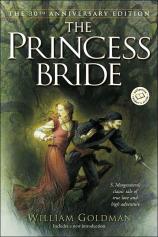Reading Group Guide
Discussion Questions
The Princess Bride

1. William Goldman states that he is adapting The Princess Bride from a novel written by the great Florinese writer, S. Morgenstern. Do you believe that there really is such a person? Why or why not? And why do you think Goldman might want to confuse readers about this point? Is that confusion necessary for the kind of story he is trying to tell?
2. Goldman, in his parenthetical asides to readers, refers to Morgenstern as a satirist and the "unabridged version" of The Princess Bride as a satire. Webster's Dictionary defines satire as "a usually topical literary composition holding up human or individual vices, folly, abuses, or shortcomings to censure by means of ridicule, derision, burlesque, irony, or other method sometimes with an intent to bring about improvement." Going by this definition, is the "good parts" version of The Princess Bride a satire? If you think it is, explain why, and what is being satirized. If not, what kind of book is it?
3. The Princess Bride is also considered to be a fantasy. The paperback version, published by Del Rey Books, is actually marketed that way-just look at the spine. The most famous fantasy novel of the twentieth century is J.R.R. Tolkien's The Lord of the Rings. In what ways does The Princess Bride resemble Lord of the Rings? In what ways is it different?
4. Goldman wrote the screenplay for the film version of The Princess Bride. There are many differences between the two. Identify as many as you can. Why do you think Goldman made these changes? With which of his choices do you agree? Disagree?
5. Why do you think that Goldman inserts himself as a character in his own novel? What other books have you read where the author adopts this narrative strategy?
6. Does Goldman present himself as a sympathetic character? Think about how he describes his relationships with his wife, son, and father. How do these relationships illustrate the fictional Goldman's virtues and faults? And do you think Goldman is portraying his actual wife, son, and father, or are they also fictionalized characters?
7. The Princess Bride can be thought of as two intertwining tales, one focusing on Westley and Buttercup, the other on the life of Goldman himself (or the fictional Goldman, at any rate). How do these two stories parallel and play off of each other?
8. Should writers draw a firm line between fact and fiction? If a writer puts himself into his story, does he have a moral obligation to be truthful about himself, or is he free to treat himself (and any other real-life person similarly inserted) as a fictional character?
9. When we first meet Inigo and Fezzik, they are working with Vizzini to kidnap Buttercup. Later, they become allies of Westley in his efforts to rescue her. What causes Inigo and Fezzik to change . . . or do they really change at all over the course of the novel?
10. Is Goldman's portrayal of Buttercup misogynistic? Is there a pattern in the way that women are portrayed in The Princess Bride, from the starlet Sandy Sterling to Goldman's psychoanalyst wife, Helen, to the lawyer Karloff Shogg, who appears in the Buttercup's Baby addendum?
11. Compare the relationships between men-such as Goldman and his father, Fezzik and Inigo, Inigo and Domingo, and Goldman and his son-and those between men and women, especially Westley and Buttercup. Which are presented more positively? Why do you think that is?
12. Is Westley's initial anger at Buttercup for agreeing to marry Humperdinck fair? Based on his actions and words, including, at one point, striking her, might Westley be considered an abuser? Are his demonstrated attitudes toward women reinforced or undermined by the text, both in his own story and in Goldman's comments?
13. Count Rugen is certainly a sadist, as is Prince Humperdinck. Other characters display submissive or even masochistic behaviors-as, for example, early on, when Westley repeatedly replies "As you wish" to Buttercup's petty commands. How do these strains of sadism and masochism color the portrayal of true love in The Princess Bride?
14. In the introduction, Goldman writes: "But take the title words-'true love and high adventure'-I believed that once. I thought my life was going to follow that path. Prayed that it would. Obviously it didn't, but I don't think there's high adventure left any more." Later, he adds: "And true love you can forget about too." Does the rest of the book offer support for these words, or does it refute them?
15. In another parenthetical aside from Goldman, he quotes the mother of one of his childhood friends, Edith Neisser, the author of "terrific books on how we screw up our children," as telling him: "Life isn't fair, Bill. We tell our children that it is, but it's a terrible thing to do. It's not only a lie, it's a cruel lie. Life is not fair, and it never has been, and it's never going to be." Do these words sum up the theme of the novel? Why or why not?
16. A search of the Internet reveals that Edith Neisser is a real author, just as Goldman claims. How does this knowledge affect your opinion of Goldman's veracity about the existence of S. Morgenstern and other questions?
17. Is Goldman laughing with his readers . . . or laughing at them?
The Princess Bride
- Publication Date: July 15, 2003
- Genres: Fiction
- Paperback: 429 pages
- Publisher: Ballantine Books
- ISBN-10: 0345418263
- ISBN-13: 9780345418265







